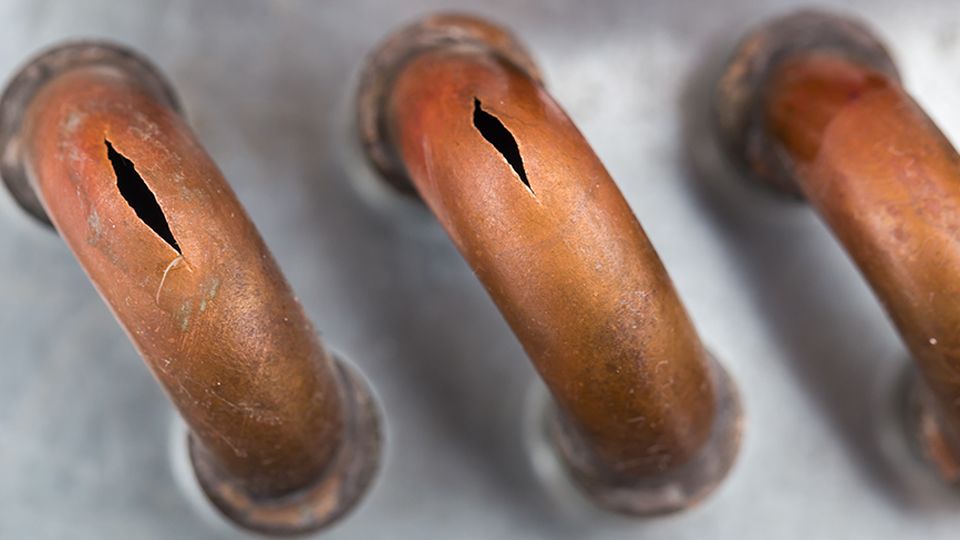
Life with Cracks – Fracture Mechanics Calculation Methods

In this training, you will learn methods for FE modeling of cracks as well as the most important fracture mechanics parameters. This training is offered as a 3-day course.
Duration
3 days
Prerequisites
Basic knowledge of Ansys Mechanical
Software used
Ansys Mechanical
- Avoid component failure due to unstable crack growth
- Automatic crack progress analysis in Ansys Mechanical
- Assess crack stability using a fracture mechanics strength verification
- Determine the remaining service life – establish the necessary inspection intervals
Description
Unlike conventional strength assessments with stresses and strains, fracture mechanics takes compromised material properties into account such as pores, cavities, inclusions, or cracks. Flaws in the component are accepted and represented as cracks in the component. Damage-tolerant measurement provides tools for predicting the behavior of cracks under load. This allows statements to be made about operational safety, such as stable or unstable crack propagation and remaining service life, as well as further measures such as inspection cycles. The FKM guideline provides support in the application and interpretation of the fracture-mechanical verification.
In Ansys Mechanical, there are various options for representing cracks in the component. In this training, you will learn about the methods for modeling cracks as well as the most important fracture mechanics parameters. One highlight is the possibility of performing automatic crack propagation analyses. By applying the fracture-mechanical verification, you assess the stability of the cracks in the component under static and cyclic loads and thus obtain valuable information about the remaining service life of your product or the determination of the necessary inspection intervals.
Detailed agenda for this 3-day training
Day 1
01 Knowing the backstory
- Controlling component failure
- Crack formation and crack growth
- Questions that can be answered using fracture mechanics
- Classifications in fracture mechanics
- Stress field at the crack tip and full plasticity failure
- Sample discussion: 2D analysis with crack
02 Characteristic variables in fracture mechanics
- Life cycle of a component
- Crack opening types
- Overview of the most important parameters for fracture mechanics evaluation
- Calculation of the energy release rate with the crack closure integral (VCCT method)
- Exercise: Torn sheet of paper
03 Linear-elastic fracture mechanics (LEFM)
- Linear/elastic material behavior
- Calculating the stress intensity factors (K factors)
- Considerations regarding the size of the plastic zone at the crack tip
- Application of the "Semi-Elliptical-Crack" object
- Workshop: semi-elliptical surface crack at pipe joints
04 Surface cracks in Ansys Mechanical
- Applicable material laws and element formulations
- Discretization at the crack tip
- Increasing the accuracy of results with the unstructured mesh method (UMM)
- Handling different crack shapes in Ansys Mechanical
- Mapping surface cracks with the "Arbitrary Crack" object
- Demo: modeling and evaluating arbitrarily shaped surface cracks
Day 2
05 Elastic-plastic fracture mechanics (EPFM)
- Parameters for nonlinear material behavior
- Motivation and determining the J-integral
- Evaluating the stable crack growth using crack resistance curves
- Exercise: CT (compact tension) probe under a monotonously increasing load
06 Difference between LEFM and EPBM
- CTOD: Crack Tip Opening Displacement
- CTOA: Angle, J-Integral
- Conversion of different fracture mechanics parameters
- FAD concept: static evaluation according to the FKM guideline
- Exercise cracked cylinder: Assessment of critical crack size according to the FAD concept
07 User-defined crack forms
- “Pre-meshed crack” object
- Define cracked and non-cracked areas via "Shared Topology" in the modeler
- Manual crack tip meshing with contour meshes
- Define crack coordinate system for planar crack faces
- Local crack propagation direction for general crack forms
- Exercise: Analysis of a cracked excavator axle
08 Loaded crack faces and advanced meshing options
- Boundary conditions on crack faces
- Analysis settings for crack models
- Utilization of symmetries
- Building a crack model using mesh assembly and node merge
- Half symmetry in crack models
- Exercise: piston with non-plane crack
Day 3
09 Fracture mechanical strength verification according to the FKM guideline
- Overview of FKM guideline for fracture mechanics verification
- Using the guideline as a useful data collection
- Strength verification for static loads
- Remaining service life and cyclic loading
- Exercise: Determining the reserve factors and the remaining service life of a cracked cylinder
10 Crack growth with SMART under static load
- SMART: Crack growth through successive remeshing of the crack tip
- Simulation of crack growth under static loading
- Recommendations for load and solution control
- Evaluation using Fracture Probes
- Exercise: Cracked cylinder under static load
11 Crack growth under cyclic loading with SMART
- Recommendations for boundary conditions and solution control under cyclic loading
- Comparison with the specifications of the FKM guideline
- Definition of one crack and multiple cracks
- Demo: Crack propagation in a panel with three cracks
- Exercise: Cyclic crack growth on a cylinder with SMART
12 Additional possibilities of the MAPDL solver (outlook)
- Analysis of failure of bonded structures: debonding behavior with the Cohesive Zone Model (CZM)
- XFEM (eXtended Finite Element Method): Crack mapping and growth inside elements
- Demo: Analysis of cracked cylinder using XFEM
Your Trainers

Klaus Graf

Dr.-Ing. Martin Seitz

Andreas Veiz
Placement in the CADFEM Learning Pathway
Participant data
Additional information
Commentary
Whether eLearning, classroom courses, live online training or customized workshops - together we identify the best option for you.
Do you have questions on the training?
If you book through your university, you will receive a 50% discount on the stated fee on training courses and eLearning courses.
For more information on the validity and how booking with the code ACADEMIC50 works, please visit our page on training for academic users.
Straight after you sign up, an automatic confirmation of receipt will be sent to the email addresses you provided. Once you have successfully verified the data you provided, you will receive your personalized sign-up confirmation, containing further information on course fees, the billing address, etc., by email within two to three working days.
As soon as the minimum number of attendees has been reached, you will receive a final training confirmation containing further information. If you have booked an on-site training, we recommend that you wait until you have received this final confirmation before booking your travel and accommodation.
If the minimum number of attendees is not reached, we reserve the right to cancel the training seven days before it is due to start at the latest. We are happy to inform you on changing your booking to an alternative date. Please note that we accept no liability for hotel or travel bookings that attendees have already made.
Usually the training courses start at 9:00 am and end at 5:00 pm of the respective local time. The actual course times will be stated in the booking confirmation. Please note that, depending on the training host, there may be a possible time shift between your and the provider's local time. Therefore all local times are provided with the valid time shift to Greenwich Mean Time (GMT).




